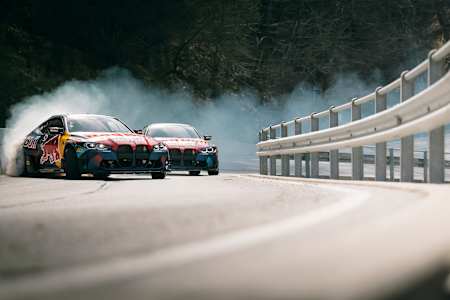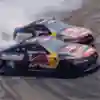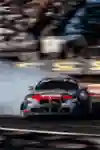
Let the Red Bull Driftbrothers guide you on the finer points of drifting
How does drifting work?
There's no doubt it looks spectacular, but what exactly is a drift?
Basically, drift is controlled oversteer. Either the car corners faster than it should or it accelerates very hard in the corner, causing the rear axle to skid as the rear tyres lose traction.
An engineer would put it like this: the slip angle on the rear axle is significantly larger than the slip angle on the front axle.
Welcome to drifting, where smoke billowing out of your car is actually good
© Jaanus Ree/Red Bull Content Pool
So if you slide on ice or in a wet parking lot, is that drifting?
From our point of view, no. Aside from the fact that you should leave that in a parking lot, that's uncontrolled rear-end swerving. By definition, a drift is very controlled, because the car does what you want it to do and not the other way around.
In drifting, everyone can build their car in the way that best suits their personal style. That's unique to our sport
What characterises drifting as you see it?
Drifting is probably the coolest thing you can do with a car. It's also the only motorsport on four wheels where the driver's style is also included in the evaluation in addition to driving technique and skill. In this respect, drifting is like surfing, snowboarding or skateboarding, where a lot also depends on personal style.
Drifting is extremely visual and extremely individual. It starts with the extroverted cars, runs through the comparatively open regulations as far as technology is concerned, and ends with the drivers.
So how does a drift work?
There are thousands of ways to manoeuvre a car into a corner for the first time. You just have so many different options as to how and when you put your car into the curve, at what angle and then how you transition from one direction of drift to the other.
Top tip: if you're going straight, you're doing drifting all wrong
© Tyrone Bradley/Red Bull Content Pool
How do your styles differ from each other?
We're actually quite different when it comes to driving. I drive very much by instinct: I hear, sense and feel the car. Eli is more of a technician. He sees the optimal line and follows it in a very calculated way.
That sums it up quite well. It's not that I don't drive by feel, but I also look at what the car can and would do on its own. I try to find harmony between what the car wants and what I think it should do. For this, I have my reference points and my line.
How does judging work in drifting?
There are basically four criteria:
1. Speed - the faster, the better
2. Drift angle – the larger the better, but remembering that the larger the angle the slower the car will be. A good compromise needs to be found here.
3. The line – this is specified, so drivers have to approach certain points precisely, sometimes with the front, sometimes with the rear.
4. The style - the most important criteria. Above all, the evaluation here is how the drift is initiated and how the car is moved, if there are many corrections in the steering wheel, how high the percentage of throttle use is, etc.
There are usually three judges who evaluate each driver separately. It gets exciting in the twin battle, the supreme discipline of our sport. In the twin battle, two drivers compete against each other, one lap as a leader in front and one lap as a chaser. The competitor in front drives according to the four criteria mentioned above, while the one in back tries to stay as close to the man in front as possible. The closer to his rival's rear, the better it's rated.
What makes a drift car special?
What's the difference between a drift car and a normal car?
It's mainly through the front axle. Because we always countersteer – i.e. to the left in a right-hand turn and to the right in a left-hand turn – and want to drive at a wide angle, drift cars have significantly more steering angle than ordinary vehicles. A steering angle of 35 to 45 degrees would be normal and drift cars have a steering angle of 70 to 80 degrees.
A drift car also has to be rear-wheel drive. It's also possible to build an all-wheel drive drifter, but that has very little to do with classic drifting. The car behaves completely differently with all-wheel drive. Another important aspect is the cooling. Although we bank the car and let it drift, we want maximum grip on the rear axle. To do that, we need very powerful engines. The more power you have in the car, the more heat is generated and that's why engine cooling is a very important point. Eli's car, for example, has the cooler located in the trunk.
Things like axle kinematics, chassis tuning, balance, centre of gravity and overall set-up of the car are just as important in drifting as in any other motorsport. The bottom line is that we want optimum control of the car at high speeds.
What's the biggest difference to traditional track racing?
When you're drifting, the entire drive train is actually permanently stressed. We drive 80 to 90 percent of the time at full load. When driving a circuit, you're at least off the gas and on the brakes in the curves, so the car is a lot less stressed. We're only off the gas for a few seconds each run. As soon as the car is sideways again, we're back at full throttle.
How to start drifting
Just so we're clear, drifting on public roads isn't allowed, right?
Drifting on public roads isn't allowed and rightly so. Drifting belongs in closed-off areas, preferably racetracks.
Where can I start drifting?
There are now many opportunities in Europe to get into the sport of drifting. There are various drifting schools and, of course, you can get involved through a classic driving safety training course.
What else can prepare people for drifting?
There are a couple of drift simulations on the PC that represent the driving physics in the drift quite realistically, such as Assetto Corsa. The few that are okay make it possible to practice the coordination between the accelerator pedal, steering wheel and brakes at home.
In order to initiate a drift, you have to go over the limits of the car. That's something you have to get used to and simulations help with that.
What else does it take to start drifting?
Good coordination helps, as does a certain level of basic fitness and a healthy level of responsiveness. You can train all of that. It also helps to get into the car from time to time and to consciously perceive how the car behaves when there's a change in load, what it does when you corner, brake and accelerate.
Part of this story












